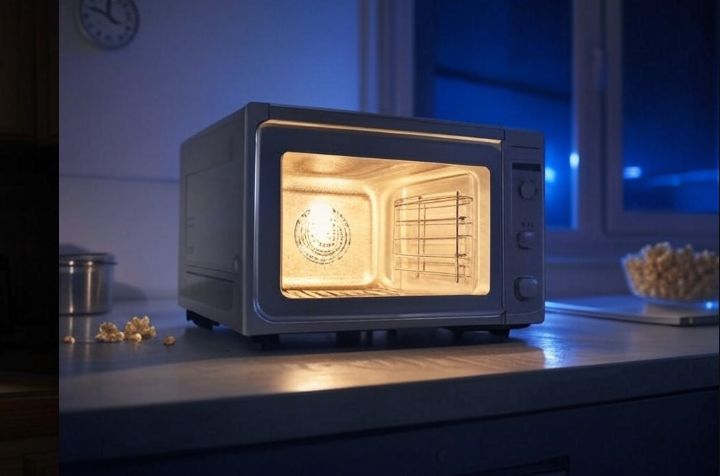Picture this: It’s 2 a.m., and I’m standing in my kitchen, pajama-clad, staring suspiciously at my microwave like it’s a double agent plotting my demise. The glow of its digital clock mocks me as I clutch a frozen burrito, whispering to myself, “Is this thing gonna turn me into a human glow stick?”. From the living room, my mom suddenly yells, “Don’t stand near the microwave! It gives off radiation!”. I mean, we’ve all been there, right? That moment when you wonder if reheating last night’s Butter Chicken is a one-way ticket to Cancer Town. Spoiler alert: It’s not. Let’s dive into the science, sprinkle in some humor, and bust this microwave-cancer myth wide open with evidence from recent heavy-hitting journal papers. Buckle up—it’s gonna be a radiant ride.
First off, let’s address the elephant in the room: microwaves sound scary. They’ve got “radiation” in their job description, and that word alone sends folks into a tizzy, conjuring images of glowing green mutants from bad sci-fi flicks. But here’s the deal—microwaves use non-ionizing radiation, which is about as harmful as your grandma’s knitting needles. Unlike ionizing radiation (think X-rays or gamma rays, the stuff that could audition for a superhero origin story), non-ionizing radiation doesn’t have the energy to break DNA or turn your cells into rogue agents. It just wiggles water molecules in your food to heat it up. That’s it. Your Butter Chicken gets hot, not your chromosomes.
To back this up, let’s peek at a 2011 study in The Lancet Oncology, Carcinogenicity of Radiofrequency Electromagnetic Fields,
This article summarizes the findings of the International Agency for Research on Cancer (IARC) regarding the carcinogenicity of radiofrequency electromagnetic fields (RF-EMF). The IARC classified RF-EMF as “possibly carcinogenic to humans” (Group 2B), indicating limited evidence in humans and less than sufficient evidence in experimental. So, unless your microwave is secretly plotting with aliens, you’re good.
Now, let’s tackle the urban legend that microwaves “leak radiation” like a sieve. I get it—nobody wants to feel like they’re slow-cooking their spleen while heating up soup. But modern microwaves are built like Fort Knox. They have metal shields and safety interlocks to keep those waves locked inside. A 2025 study in Electronics, The Numerical Assessment of RF Human Exposure to Microwave Ovens with Contact-Type Doors, found that microwave ovens emit minimal radiation well within ICNIRP safety limits, posing no health risks to the general public. However, it noted that individuals with unipolar pacemakers should maintain distance, as electromagnetic fields near microwave ovens could interfere with their devices. For everyone else, microwaves remain safe, with no evidence linking them to cancer or DNA damage. We’re talking levels so low they’re practically whispering, “We’re harmless!” Compare that to your phone, which emits similar non-ionizing radiation but doesn’t get the same side-eye. Hypocrisy, much?
Okay, but what about those horror stories where someone’s microwave turned their leftovers into a carcinogenic stew? Let’s unpack that. Some folks worry that microwaving food creates cancer-causing compounds. This myth got legs because heating food—by any method—can sometimes produce minor chemical changes. For example, overcooking meat (whether in a microwave, oven, or grill) can form polycyclic aromatic hydrocarbons (PAHs), which are linked to cancer in very high doses. But a 2023 study in Food Chemistry, Summarizing minimization of polycyclic aromatic hydrocarbons in thermally processed foods by different strategies clarified that microwaving is actually less likely to produce these compounds compared to grilling or frying, because it heats food more evenly and at lower temperatures. So, if you’re pointing fingers, your backyard BBQ is the real suspect, not your trusty microwave.
Here’s where it gets fun: the myth persists because humans love a good scare. Back in the ‘80s, when microwaves were the new kid on the block, people freaked out. They were like, “This box cooks food with invisible waves? Witchcraft!” Fast-forward to today, and we’re still shaking our fists at technology we don’t fully understand. A 2025 review in Nature Reviews Cancer put it bluntly: fear of new tech often outpaces evidence. The authors noted that despite millions of people using microwaves daily for decades, there’s no spike in cancer rates tied to them. If microwaves were handing out tumors, we’d have noticed by now—unless cancer is just really bad at RSVPing.
Now, let’s address the “what if” crowd. You know, the folks who say, “But what if long-term exposure to low-level radiation is still risky?” Fair enough—science loves a good “what if.” But consider this: the energy levels in microwaves are too weak to mess with your DNA. It’s like worrying that a feather might knock you out. Unless you’re planning to live inside your microwave (which, please don’t), you’re not at risk.
I’m not saying microwaves are flawless. They can make your pizza soggy and your coffee scalding. But cancer? Nah. The real danger is forgetting to poke holes in your Hot Pocket wrapper and ending up with a lava explosion. Pro tip: follow the instructions.
So, where does this leave us? Microwaves are safe, backed by decades of research. They don’t fry your DNA, leak death rays, or turn your leftovers into poison. The cancer myth is just that—a myth, born from fear of the unknown and a dash of technophobia. Next time you’re eyeing your microwave like it’s a supervillain, laugh it off and press “Start.” Your food will be hot, your health will be fine, and you’ll have dodged another serving of misinformation. And if at all someone warns you about microwave radiation, hit them with the facts (or just send them this article).
I’d prefer the latter option!
Written by – Ummehaani Zahir
Edited by – Dr. Reshma Patil




I truly appreciate the depth of knowledge and passion for the subject that shines through in this article. 👏🏻
Thankyou for reading!